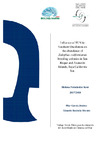Identificador persistente para citar o vincular este elemento:
https://accedacris.ulpgc.es/jspui/handle/10553/75047
| Campo DC | Valor | idioma |
|---|---|---|
| dc.contributor.advisor | García Jiménez, M. Del Pilar | - |
| dc.contributor.advisor | Reséndiz Morales, Jesús Eduardo | - |
| dc.contributor.author | Fernández Sanz, Helena | - |
| dc.date.accessioned | 2020-10-27T14:50:16Z | - |
| dc.date.available | 2020-10-27T14:50:16Z | - |
| dc.date.issued | 2018 | en_US |
| dc.identifier.uri | https://accedacris.ulpgc.es/handle/10553/75047 | - |
| dc.description.abstract | In the northwest of Baja California Sur (B.C.S.) state, two breeding colonies of California sea lion (Zalophus Californianus) are distributed in San Roque and Asunción Islands, susceptible to the Niño Southern Oscillation (ENSO) phenomenon. The total population size of this species is difficult to determine, and has been estimated by different authors since the early 50s. Thus, there is a need to standardize the counting method and create a monitoring, management and conservation plan for the California sea lion and its habitat. In this study, abundance and population structure of Z. Californianus in San Roque and Asunción Islands, Reserva de la Biosfera “El Vizcaíno” (REBIVI), was determined from censuses carried out between 2004 and 2017 as well as its breeding season. The relationship between the ENSO phenomenon and the population abundance was analyzed. It was concluded that Isla Asunción is an important reproductive colony with a general positive growth, while Isla San Roque is an occasional occurrence colony without pups register; the breeding season was defined in the months of June, July and August. During La Niña years, the abundance of the species remains stable, and during El Niño, the abundance declines, when productivity decreases. Based on the results, it is proposed to generate a management plan for the organisms and ecosystem, as well as to establish relevant conservation strategies together with the authorities. | en_US |
| dc.language | eng | en_US |
| dc.subject | 240119 Zoología marina | en_US |
| dc.subject | 310510 Dinámica de las poblaciones | en_US |
| dc.subject.other | El Niño Southern Oscillation (ENSO) | en_US |
| dc.subject.other | Sea lions | en_US |
| dc.subject.other | Baja California Sur | en_US |
| dc.title | Influence of El Niño Southern Oscillation on the abundance of Zalophus californianus breeding colonies in San Roque and Asunción Islands, Baja California Sur | en_US |
| dc.type | info:eu-repo/semantics/bachelorThesis | en_US |
| dc.type | BachelorThesis | en_US |
| dc.contributor.departamento | Departamento de Biología | en_US |
| dc.contributor.facultad | Facultad de Ciencias del Mar | en_US |
| dc.investigacion | Ciencias | en_US |
| dc.type2 | Trabajo final de grado | en_US |
| dc.utils.revision | Sí | en_US |
| dc.identifier.matricula | TFT-46448 | es |
| dc.identifier.ulpgc | Sí | en_US |
| dc.contributor.buulpgc | BU-BAS | en_US |
| dc.contributor.titulacion | Grado en Ciencias del Mar | es |
| item.grantfulltext | restricted | - |
| item.fulltext | Con texto completo | - |
| crisitem.advisor.dept | GIR IUNAT: Biología Integrativa y Recursos Biológicos | - |
| crisitem.advisor.dept | IU de Estudios Ambientales y Recursos Naturales | - |
| crisitem.advisor.dept | Departamento de Biología | - |
| Colección: | Trabajo final de grado Restringido ULPGC | |
Visitas
136
actualizado el 01-mar-2025
Descargas
21
actualizado el 01-mar-2025
Google ScholarTM
Verifica
Comparte
Exporta metadatos
Los elementos en ULPGC accedaCRIS están protegidos por derechos de autor con todos los derechos reservados, a menos que se indique lo contrario.
